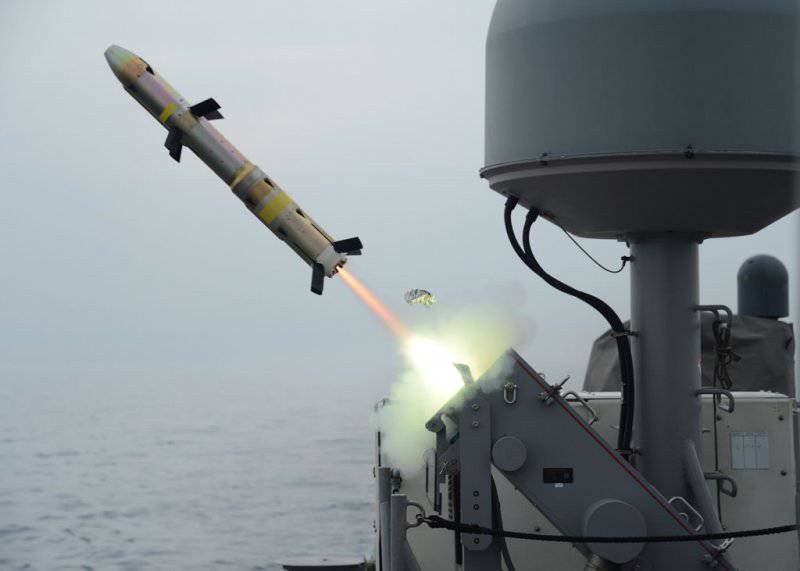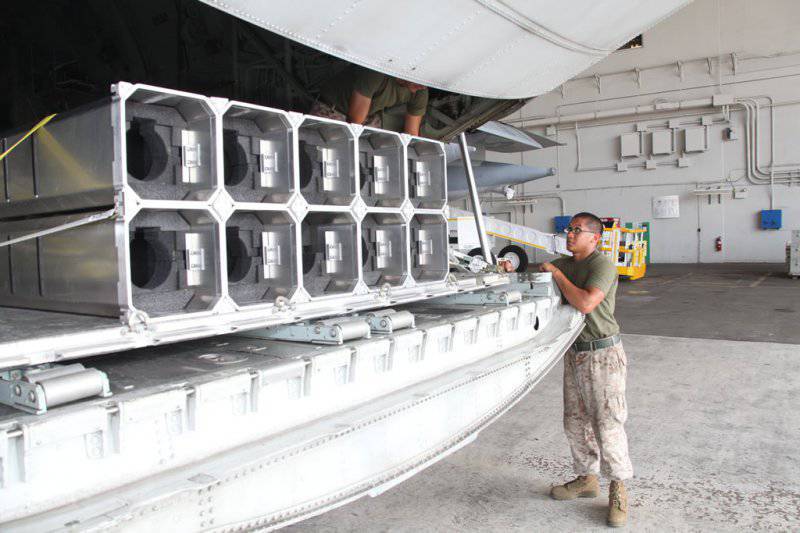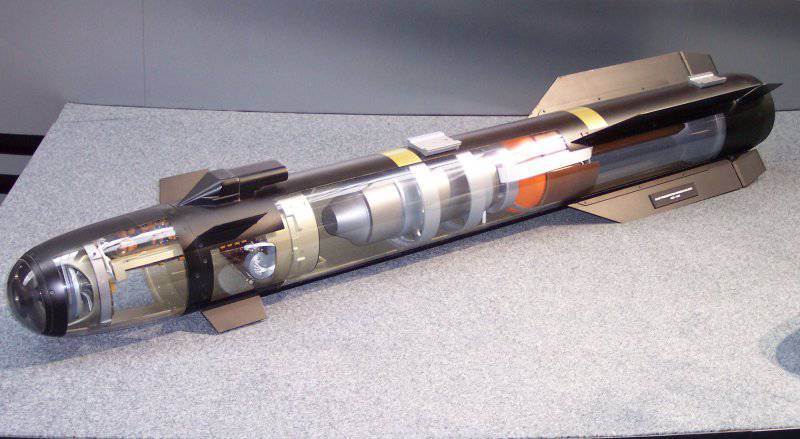Raytheon AGM-176 Griffin (USA)
The result of the AGM-176 Griffin (“Griffin”) project was to create a new air-to-surface guided missile. First of all, this weapon was intended to equip the aircraft AC-130 latest modifications. It was assumed that the expansion of the range of weapons of these "gunships" would allow, to a certain extent, to reduce the cost of their operation due to the possibility of using missiles that most meet the requirements of a particular situation. In addition, the possibility of arming new types of aircraft and helicopters of other types was considered.
In order to attract potential customers, it was decided to make the new rocket as cheap as possible. The main method of reducing its cost was the use of existing components used in the production of other types of guided weapons. The main "donors" of components and assemblies were the anti-tank missile system FGM-148 Javelin and the air-to-air missile AIM-9X Sidewinder. However, a number of nodes had to be developed specifically for the Griffin rocket.
The AGM-176 rocket has a look typical for weapons of its class. Its total length - 110 cm, caliber - 140 mm. Steering wheels and stabilizers are provided on the side surface of the cylindrical body. All planes are built according to the X-shaped scheme and are made folding. In the transport position, the steering wheels and stabilizers are located inside the rocket body. The ammunition itself is supplied in a cylindrical transport and launch container. The starting weight of the Griffin rocket is 20 kg, 5,9 kg of which falls on the warhead.
The rocket has a classic layout. In the head part is the guidance system, behind which is a high-explosive fragmentation warhead. In the middle and tail parts of the body there is a solid fuel engine.
In order to expand the list of possible carriers of new missiles, it was proposed to develop two modifications that differ from each other by the launch method. Thus, the AGM-176A (Griffin-A) variant was proposed to be launched using special launchers mounted on the aft ramp or side doors of transport aircraft. The AGM-176B (Griffin-B) missile was to be used with standard external suspension components for combat aircraft and helicopters.
The first modifications of the AGM-176 rocket were equipped with a combined homing head. Depending on the tactical need, you can use a combination of inertial and satellite navigation systems or semi-active laser seeker. In the first case, the rocket seeks to get to the point with the specified coordinates, in the second - it is induced on the spot of the laser beam, which illuminates the target.
The small size and weight of the Griffin missile did not allow for a longer range. However, there are ways to significantly increase this parameter. When launched from a ground launcher mounted on any vehicle, the firing range does not exceed 5,5 km. When using a rocket as an aircraft, its range can reach 15-20 km, depending on the height at which the launch is made.
AGM-176 rockets carry high-explosive fragmentation warheads weighing 5,9 kg. Currently, Raytheon specialists are working on fine-tuning a new multi-purpose MEWS warhead capable of striking various types of targets. The missile warhead is equipped with a fuse operating in several modes. An air blast is provided over the target, an explosion in contact with the target or with a delay.
As early as 2008, Raytheon received several orders from the US Department of Defense for a number of project phases, as well as for the production of the first experienced missiles. In June, the 2009-th Pentagon allocated 14,5 million dollars to prepare for testing and mass production of new missiles. At that time, it was about AGM-176A and AGM-176B modifications. In the autumn of 2010, work began on integrating the Griffon missiles into the armament complex of modern American UAVs.
In early 2011, it became known that the US Navy became interested in the AGM-176 project. Shortly before this command fleet stopped the NLOS-LS contest, the purpose of which was the choice of short and medium-range missiles for new ships of the LCS project. As such weapons, they began to consider new Griffin rockets in a version called SeaGriffin ("Sea Griffin").
In 2011, the Pentagon purchased a number of Griffin rockets designed for use with various aviation platforms. In early November of that year, there were reports of the first combat use of new missiles. It took place in Afghanistan. The launch was carried out from the aircraft KC-130J-HH. In 2012, tests of missiles of new modifications with different launchers continued.
In February, 2014, the company Raytheon began production of another modification of the Griffon missile called AGM-176B Block III. The main changes affected the laser homing head, the characteristics of which were significantly improved. Also, the 3 Block missiles are completed with the new multi-purpose MEWS warhead. In February, Raytheon reported that the two-thousand Griffin family rocket rolled off the assembly line.
A little later, in the spring of 2014, the full-fledged operation of the Griffin-B missiles in the US Navy began. Cyclone patrol boats of the project are equipped with the MK-60 missile system, which includes a launcher, an AGM-176B rocket, a laser target designator and a control system.
In April, the 2014-th Pentagon announced that the new LCS class ships would not be equipped with SeaGriffin missiles. As missile weapons designed to attack small targets, ships will receive an AGM-114L Hellfire missile. At the same time, however, such a refusal should in no way affect the operation of the “Griffins” as weapons of other boats and ships.
Despite the setback, Raytheon continues to develop a ship-based missile project. It is assumed that this rocket may be of great interest to the military due to several qualities. The main thing is the increased flight range, thanks to which SeaGriffin can compete with AGM-114L and Brimstone 2 missiles. In addition, the missile for ships is equipped with a combined control system with laser and infrared homing heads. In the case of using infrared GOS, the principle of "shot-and-forget" is implemented.
In July, 2014 was tested by the SeaGriffin rocket, the purpose of which was to test its characteristics and demonstrate the desire to continue the project. A little later it became known that the SeaGriffin rocket received a new name - AGM-176C. In addition, it became known about the start of work on the AGM-176C-ER extended-range missile.
Thus, at the moment, the list of modifications of the Gryphon rocket is as follows:
- AGM-176A or Griffin-A. Rocket for armament of aircraft AC-130 or some military transport vehicles. This modification is intended for use with a launcher mounted on the stern load ramp or in the side doors of the base aircraft;
- AGM-176B or Griffin-B. Air-to-surface missile intended for use on combat aircraft and helicopters. This ammunition should be transported on an external sling and is launched ahead of the flight;
- AGM-176C or Griffin-C. Initially, the ship version of the base rocket with a new control system using laser and infrared guidance. Depending on the type of target and other features of the combat mission, semi-active targeting of a laser tag or targeting a target chosen by the operator can be used;
- AGM-176C-ER. Further development of the Griffin-C rocket with an updated power plant. It is alleged that when launched from a ground-based launcher, this missile is capable of hitting targets at a distance of more than 10-15 km.
Currently, Raytheon produces the Griffin-A and Griffin-B missiles. Projects with the letter “C” are still at the stage of testing and refining prototypes. Arms for ships are planned to be presented to potential buyers in the very near future.
On the materials of the sites:
http://raytheon.com/
http://defenseindustrydaily.com/
http://airforce-technology.com/
http://defensenews.com/



Information